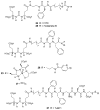GCPII imaging and cancer
- PMID: 22304713
- PMCID: PMC4076792
- DOI: 10.2174/092986712799462612
GCPII imaging and cancer
Abstract
Glutamate carboxypeptidase II (GCPII) in the central nervous system is referred to as the prostate-specific membrane antigen (PSMA) in the periphery. PSMA serves as a target for imaging and treatment of prostate cancer and because of its expression in solid tumor neovasculature has the potential to be used in this regard for other malignancies as well. An overview of GCPII/PSMA in cancer, as well as a discussion of imaging and therapy of prostate cancer using a wide variety of PSMA-targeting agents is provided.
Figures







References
-
- Halsted CH. The intestinal absorption of folates. The American journal of clinical nutrition. 1979;32(4):846–55. - PubMed
-
- Sirotnak FM, Tolner B. Carrier-mediated membrane transport of folates in mammalian cells. Annual review of nutrition. 1999;19:91–122. - PubMed
-
- Fowler B. The folate cycle and disease in humans. Kidney International Supplement. 2001;78:S221–9. - PubMed
-
- Moran RG. Roles of folylpoly-gamma-glutamate synthetase in therapeutics with tetrahydrofolate antimetabolites: an overview. Seminars in Oncology. 1999;26(2 Suppl 6):24–32. - PubMed
-
- Ghosh A, Heston WD. Tumor target prostate specific membrane antigen (PSMA) and its regulation in prostate cancer. J Cell Biochem. 2004;91(3):528–39. - PubMed
Publication types
MeSH terms
Substances
Grants and funding
LinkOut - more resources
Full Text Sources
Other Literature Sources
Miscellaneous

